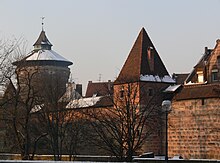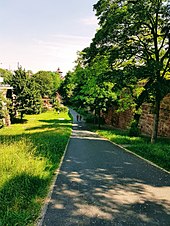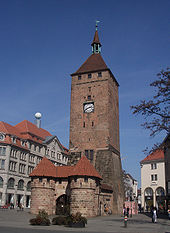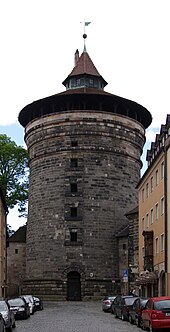City wall (Nuremberg)
The city wall is one of the most important art and architectural monuments in the city of Nuremberg . In the north, the extensive castle complex is fully integrated into the fortification.
In its long history has been Nuremberg taken only once by military means: 1945 by the Americans. The fact that this had never happened before is due not least to the city fortifications, which were considered insurmountable in the Middle Ages .
The penultimate city wall
The first fortifications are believed to be as early as the 11th century. In the 13th century, the districts on both sides of the Pegnitz , the Sebalder and the Lorenzer Siedlung, were fortified separately. On the Sebald side, next to the castle and the Tiergärtner Tor in the north, especially the Laufer Schlagturm in the east has been preserved. On the Lorenz side there is still the White Tower in the west of the old town.
Remnants of the old city moat have been preserved on Grübelstrasse (Herrenschießgraben), Peter-Vischer-Strasse (Katharinen- and Tiergraben) and Mühlgasse (Klettengraben).
It was not until 1320–1325 that the two parts were brought together across the river by walls: the executioner's tower and the water tower still stand in the west, and the debt tower on the island of Schütt in the east .
The last city wall
The last city wall was closed in 1400, was five kilometers long and formed a crooked parallelogram . Four gate towers were built at its four corner points.
The city wall was divided into the actual city wall (also known as the high wall), the ground-level and 15-meter-wide kennel in front of it , the kennel wall rising from the moat and the dry moat. A total of about 130 moat and wall towers can be identified. The trench dug around 1430 with a view to the Hussite Wars was an average of 12 meters deep and up to 20 meters wide, but never filled with water. In 1452 the construction of the trench was completed.
Access to the city was made possible by seven gates: the five main gates with the old zoo gate and the four new gate towers ( Laufer Tor , Frauentor , Spittlertor and Neutor ) as well as two pedestrian passages ( Hallertürlein on the north bank of the Pegnitz in the west and Wöhrder Türlein in the east). There was also the Vestnertor leading to the castle . Where the Pegnitz leaves the city, it was imposingly spanned by the Fronveste from 1489/94; in the east the Tratzenzwinger secured the entry of the river.
The towers of the city wall were named in 1540 with a combination of colors and letters (see also seven-colored alphabet ): the black section begins in the north at the castle (Luginsland Schwarz A ) and extends to the island of Schütt in the east (tower Schwarz Z ) . There the blue section begins with blue A and extends to blue X in the south at the Frauentormauer, where it merges with red A into the red section, which leads to red Z at the Spittlertormauer in the west, continues from green A and with green O. ends again at the castle. These old names can be seen on the towers.
Extensions
Already before 1500, work began on rebuilding the fortifications and redesigning the kennels in cannon positions: In the so-called remarrying, either the height of the kennel wall was reduced and the kennel was raised or the kennel wall was reinforced with a wall with cannon slots. In addition, old kennel towers were rebuilt or demolished and new towers and bastions were built. The redesign began with the entry and exit of the Pegnitz and ended at the wall north of the Frauentor .
In 1527 the Küblerzwinger (also called Dürerbastei) was built in the northeast and the Tucherzwinger, each as a round bastion, in the southwest; 1538–45 the castle bastions (Vestnertor-, Great and Lower Bastion) were built in the north and west of the castle.
In 1556-64 the four gate towers were encased and got their current, impressive appearance: the Laufertorturm ( Laufer Tor in the northeast), the Frauentorturm (Frauentor in the southeast), the Spittlertorturm ( Spittlertor in the southwest) and the Neutorturm ( Neutor in the northwest).
1611-14, the Zwingermauer south of the Laufer Tor was renewed and the Wöhrdertor bastion was erected, which was demolished in 1871.
After that, the city wall was hardly adapted to the state of defense technology. On the plan by the draftsman Hans Bien (Bien map) you can see the state of the wall around 1628/32. As early as the Thirty Years' War Nuremberg was protected by entrenchments far from the city limits .
Adaptations to modern times
The longer period of economic stagnation up to industrialization in the 19th century had a museum-like effect, as was the case with the old Nuremberg buildings. In 1824 the chain walkway designed by the mechanic Conrad Georg Kuppler was erected in front of the Fronveste , in 1930 massive supports were added and the whole bridge was renovated in 2010.
When Bavaria took over in 1806, the city retained its fortress status. The five main gates were guarded and three other gates were locked at night. The traffic to the suburbs (e.g. Wöhrd and Gostenhof ) grew steadily, but by 1866 only seven further city gates were approved, which were included in the guard system: in 1848 the Max -, the Färber - and the Kasemattentor, in 1850 the Königstor , 1859 Marientor , 1863, the west gate and 1866 Ludwigstor ; they were built as neo-Gothic city gates. An application made by the city to de-fortify in 1863 was rejected, as Munich's fortress property was viewed as a stabilizing factor for fear of unrest. On July 12, 1866, the demolition was approved, also in anticipation of a Prussian occupation. In the following years there were repeated arguments about the preservation or demolition of the city wall, for the time being the king reserved the final decision on any structural change. In 1869 the first wall was demolished and further demolitions followed.
Due to the growing traffic, the seven newly built gates were torn down again from 1877 to 1891. Further breakthroughs in the wall were made: the Sterntor in 1869 , the Wöhrder Tor in 1871 , the Hallertor in 1881 and the Fürth Gate in 1894 in the form of a bridge .
During the Second World War , the city fortifications were severely damaged by air raids . On October 3, 1944, for example, the Fronveste on the Pegnitz was badly hit in a daytime attack. After the war, the destruction was partially repaired.
In the 1960s, parts of the Frauentorgraben in the south were filled in. During the construction of the U2 underground line , this section of the trench was exposed again in 1987. Plans for an extensive redesign of the area around the Königstor / Marientor wall (Köma project) in 1967/68 were not implemented.
Current condition
Even though it has been heavily restored or rebuilt in parts, the city wall has been almost completely preserved and surrounds the old town. The largest gap is over 310 meters at the Laufer gate tower ( 49 ° 27 ′ 28 ″ N , 11 ° 5 ′ 18 ″ E ). The preservation of the wall is an ongoing process. In 2005, for example, the Maxtor wall in the "Küblerzwinger" area was restored.
Behind, on and in front of the wall and in the partially preserved ditch there are mostly publicly accessible walking paths. The moat itself is largely designed like a park. The mighty bastions to the west and north of the castle are set up as castle gardens and are generally accessible in the warm season.
At the end of the Second World War there were still 88 towers, today there are 71, many of which are used by organizations, associations and private individuals, for example as youth centers, advice centers, museums, artists' meeting places and rooms for students, and some of them are therefore open to the public.
In the 20th century , a retirement home was built on the western city wall near the Fronveste . The two-storey sandstone cuboid with a hipped roof is followed by other buildings. The wall towers Grünes C, D and E were integrated into the buildings of the old people's home. In the area of the Pegnitz inlet on the island of Schütt, the Tratzenzwinger extends as part of the eastern city wall , behind it two towers rise: Blaues A has been used since 1980 by the Kreisjugendring (KJR), which also operates the Neutor youth home in another city wall tower . Schwarzes Z has housed the Krakow House since 1996 .
From 1997–2003, the Museum Tower of the Senses was planned and implemented in the Mohrenturm (Green B) at the west gate .
In 2004 , a sculpture garden that belongs to the museum and is freely accessible during the day was laid out in the Zwinger am Frauentorgraben, between the Sterntor and the Frauentor, not far from the Neues Museum .
The Jakobsturm (Red L) at Jakobstor , built around 1480, was gutted in 2005 under the direction of the City Building Office and opened as a hostel for traveling journeymen; five beds, a kitchenette and a bathroom are available to the traveling companions.
Unlike in Rothenburg ob der Tauber, for example, a medieval wall with a walk-on battlement does not shape the picture. Rather, four thick towers form corner pillars, between which the walls extend.
“... There is no second bulwark of this type and size in Central Europe that has stood the test of time. The number and the variety of the buildings make the ... walling of the city a textbook of fortification technology of the Middle Ages and the early modern times ”.
Historical illustrations
See also
literature
- Albrecht Dürer : Quite a few lessons on fortification of the Stett, Castle and Flecken . Nuremberg, 1527 online PDF
- Günther P. Fehring, Anton Ress (†): The city of Nuremberg. Brief inventory , 2nd ed. by Wilhelm Schwemmer, Munich: Dt. Art publ. 1977 [un. Reprint 1982] (= Bayerische Kunstdenkmale; 10), pp. 165ff.
- Walter Haas: A piece of the older Nuremberg city wall at the Kornmarkt , in: Messages from the Association for the History of the City of Nuremberg Volume 76, 1989, p. 161 ff. - also online
- Hanns Hubert Hofmann: The Nuremberg city wall . Verlag Nürnberger Presse, Nuremberg 1967
- Reinhard Kalb: That's why every big city envies us: The most beautiful city wall far and wide . In: Nürnberger Zeitung No. 247 of October 25, 2007, Nürnberg plus, p. + 1 - online
- Erich Mulzer : The city fortifications . In: Erich Mulzer: Baedeker Nuremberg - City Guide , 9th edition. By Karl Baedeker. Ostfildern-Kemnat: Baedeker, 2000, 134 pages, ISBN 3-87954-024-1 - also online
- Kurt Müller, Erich Mulzer: The first breach in Nuremberg's city wall . In: Nürnberger Altstadtberichte, Ed .: Altstadtfreunde Nürnberg , No. 15 (1990), pp. 37–80 (documented with photographs)
- Erich Mulzer: On dealing with a possible world cultural heritage . In: Nürnberger Altstadtberichte, Ed .: Altstadtfreunde Nürnberg e. V., No. 25 (2000), pp. 27-62 (This refers to the Nuremberg city wall. Documented with photographs)
- Franz Willax: Nuremberg city wall in the decade before the Thirty Years War . In: Messages from the Altnürnberger Landschaft e. V., 1990, No. 1, pp. 210-214
- Franz Willax: The fortifications Gustav Adolfs von Schweden um Nürnberg 1632. In: Mitteilungen des Verein für Geschichte der Stadt Nürnberg, Vol. 82, 1995, online
Web links
- Michael Metzner, Erlangen: The Nuremberg city wall . In: baukunst-nuernberg.de
- Bien card in the Nuremberg city map service
Individual evidence
- Michael Diefenbacher , Rudolf Endres (Hrsg.): Stadtlexikon Nürnberg . 2nd, improved edition. W. Tümmels Verlag, Nuremberg 2000, ISBN 3-921590-69-8 ( online ).
- ^ A b Helge Weingärtner: City fortifications . S. 1018 .
- ^ Wiltrud Fischer-Pache: City gates and small doors . S. 1026 .
- ^ Helge Weingärtner: Towers (alphabetical designation) . S. 1093 .
- ↑ Helge vinedresser Remparierung . S. 897 .
- ^ Helge Weingärtner: Round bastions . S. 917 .
- ^ Charlotte Bühl: Entfestigung . S. 247 .
- ^ Maritta Hein-Kremer: Köma project . S. 551 .
- Other sources
- ↑ a b http://norica.by.ru/baedeker/besicht6.html
- ↑ a b http://www.baukunst-nuernberg.de/epoche.php?epoche=Gotik&objekt=Letzt_Stadtbefestigung
- ↑ http://www.nuernberg-aha.de/architektur/renaissance/renaissance_burgbasteien.html
- ↑ Archived copy ( Memento from July 26, 2014 in the Internet Archive )
- ↑ http://online-service.nuernberg.de/stadtplandienst/spa/main.php?myClient=small&myBackground=1&myLayer=bien1630&myBBOX=4433139,5480415,462
- ^ GW Schramm: The Destruction , in 3 × Nuremberg, Verlag A. Hofmann, Nuremberg 1990, p. 79.
- ↑ http://www.viezens.de/pdf/MTMN.pdf
- ↑ http://www.burgen.strasse-online.de/4-colmberg-nuernberg/4-25-profanbauten-in-nuernberg/index.html
- ↑ [1]
















